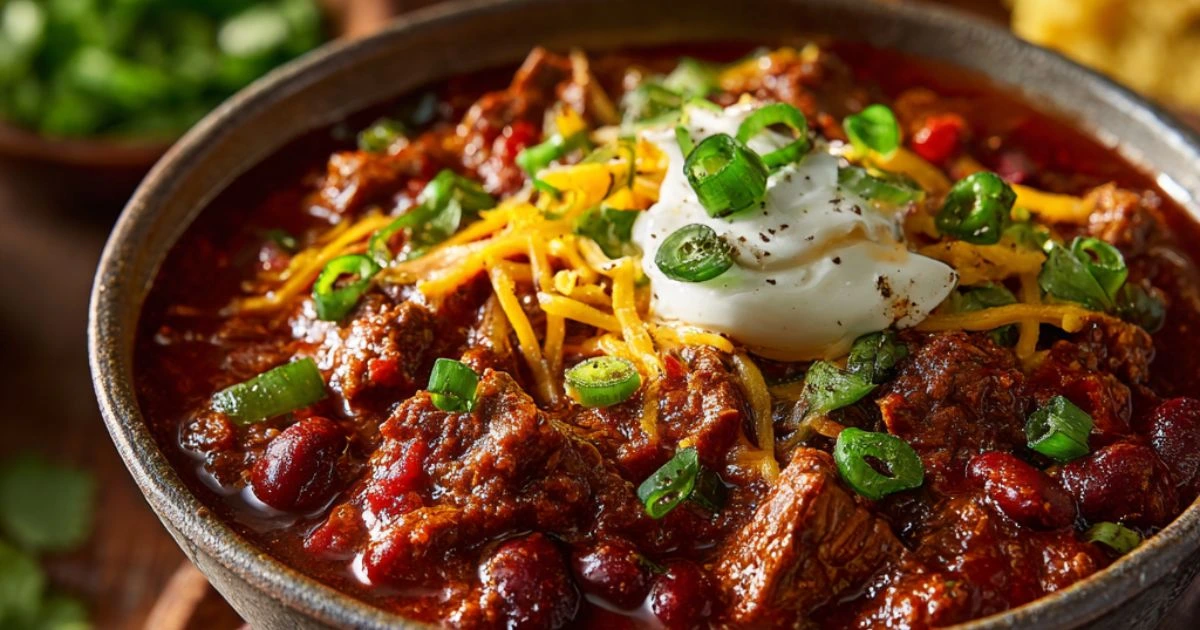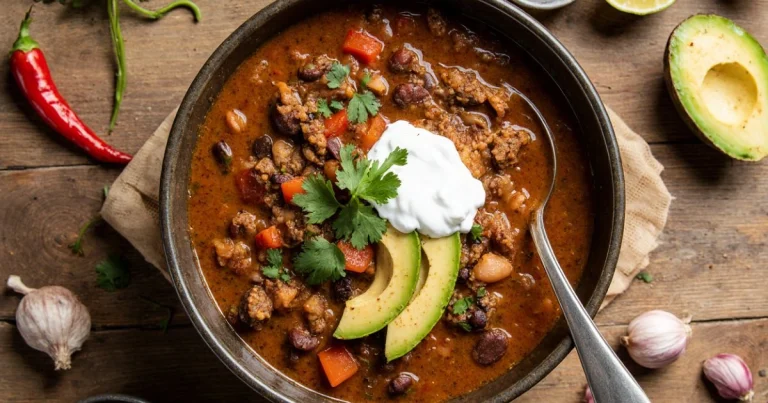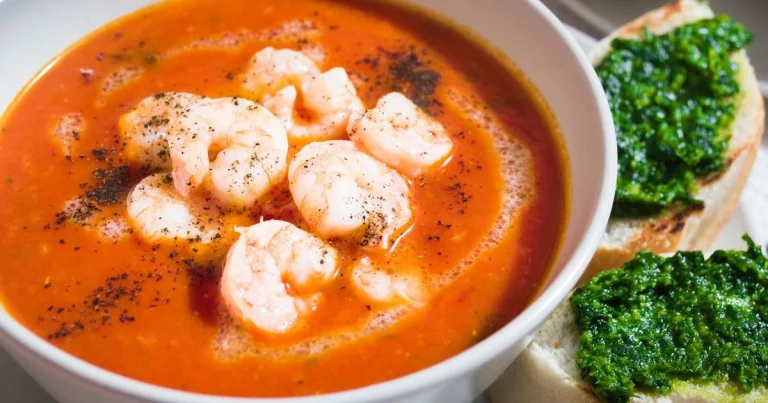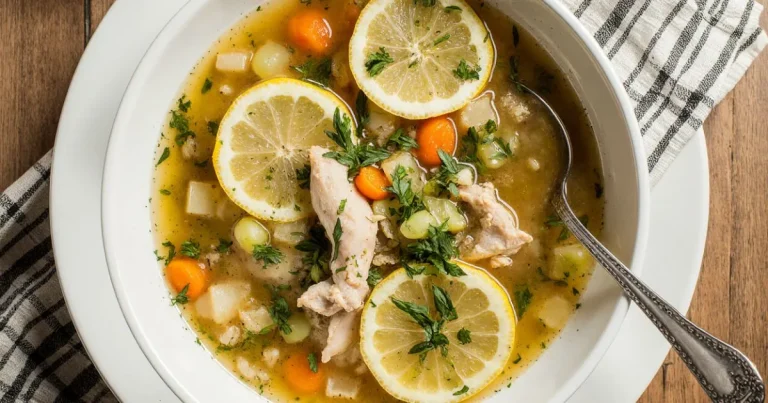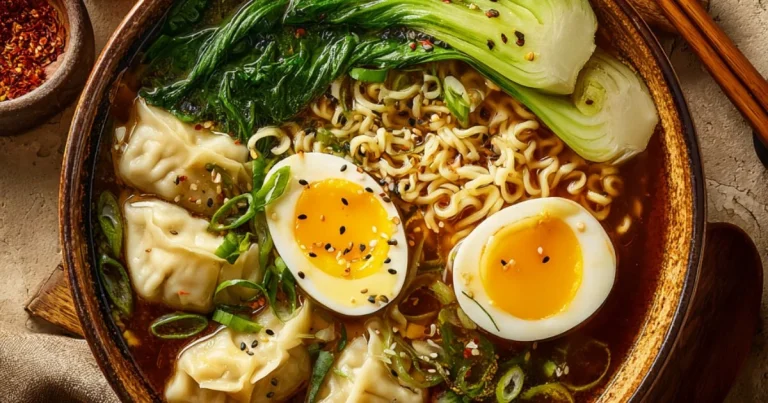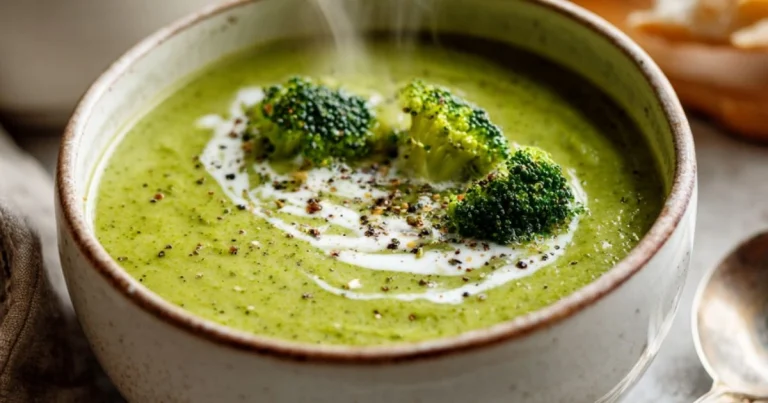Texas Chili: The Ultimate Guide to Making This Iconic Dish
When it comes to comfort food, Texas chili stands out as a bold and flavorful dish that defines the Lone Star State’s culinary tradition. With its rich history, spicy kick, and meaty texture, Texas chili is more than just a stew—it’s a symbol of pride and regional flavor. Unlike other chili varieties, it features no beans and focuses solely on the heartiness of beef, chili peppers, and an array of spices. In this guide, we’ll walk you through everything you need to know about making the perfect Texas chili from scratch, along with its history, essential ingredients, and regional variations.
What is Texas Chili?
Texas chili, also known as chili con carne (chili with meat), is a dish with deep roots in Texas’ culinary history. Unlike many chili recipes across the U.S., Texas chili is distinguished by its complete absence of beans and tomatoes. It’s all about beef, chili peppers, and a robust mix of spices.
In fact, in the state of Texas, it’s actually considered a “crime” to add beans to chili. Texas chili aficionados claim that chili should focus purely on the meat and spice, allowing the flavors of the beef and the chiles to shine.
- Origin: Texas chili traces its roots back to the 1800s, when chili was first prepared by Mexican immigrants who used dried peppers and beef to create a savory stew. Over time, this simple dish was adapted and embraced by Texas settlers.
- Cultural Significance: Chili con carne is a staple in Texas culture, often featured in local cook-offs, celebrations, and gatherings. The Texas Chili Cook-Off, for example, is one of the state’s most popular culinary events.
Key Ingredients in Texas Chili
The simplicity of Texas chili lies in its ingredients, with each one contributing to the deep flavors and rich textures. Here’s what you’ll need to create this iconic dish:
- Beef: The primary protein in Texas chili. You can use:
- Beef chuck or brisket for a more tender, juicy texture.
- Ground beef for a finer, smoother chili.
- Chili Peppers: Dried chili peppers give Texas chili its distinctive flavor. Some of the most commonly used are:
- Ancho
- Pasilla
- Guajillo
Learn more about different chili peppers in this guide to chili varieties. - Spices: A blend of ground spices enhances the flavor profile of Texas chili. The essential ones include:
- Cumin
- Paprika
- Oregano
- Cayenne (for heat)
- Aromatics: Onions and garlic provide a savory base to the dish.
- Beef Broth: Beef stock or broth is used to build a rich, savory base that helps bring all the ingredients together.
How to Make Texas Chili: Step-by-Step
Making Texas chili from scratch is easy, but it requires patience. The slow simmering process is key to developing the full flavor. Here’s a step-by-step guide:
1. Prepare the Beef
- Choosing the Cut: The best cuts for Texas chili are beef chuck, brisket, or stew meat. These cuts have enough fat and connective tissue to make the chili tender and juicy after slow cooking.
- Browning the Beef: Heat oil in a large pot and brown the beef in batches. This step adds flavor by caramelizing the meat and developing a deep, rich base.
2. Prepare the Chili Base
- Sauté the Aromatics: In the same pot, add chopped onions and garlic. Cook until soft and fragrant.
- Toast the Chili Peppers: Toast the dried chili peppers in a dry pan for 2-3 minutes until fragrant. Then, blend them with some beef broth to create a flavorful paste.
3. Simmer the Chili
- Add the Meat and Broth: Return the beef to the pot, along with the chili pepper paste, ground spices (like cumin and paprika), and enough beef broth to cover the mixture.
- Slow Cook: Allow the chili to simmer for 2-3 hours over low heat, stirring occasionally. This slow cooking process helps the flavors meld together. Texas chili benefits from being cooked low and slow.
4. Taste and Adjust Seasoning
- Taste the chili and adjust the seasoning. If you prefer a spicier chili, add more cayenne or chopped fresh jalapeños.
- If the chili is too thick, you can add more beef broth to achieve your desired consistency.
5. Garnish and Serve
- Serve with optional toppings like shredded cheese, chopped onions, and fresh cilantro. For a more indulgent experience, pair with cornbread or tortilla chips.
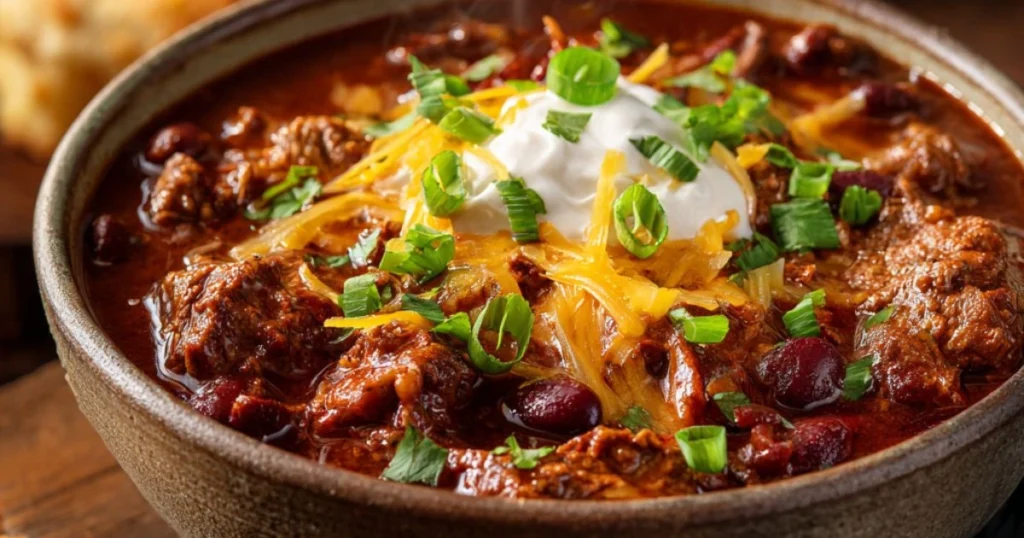
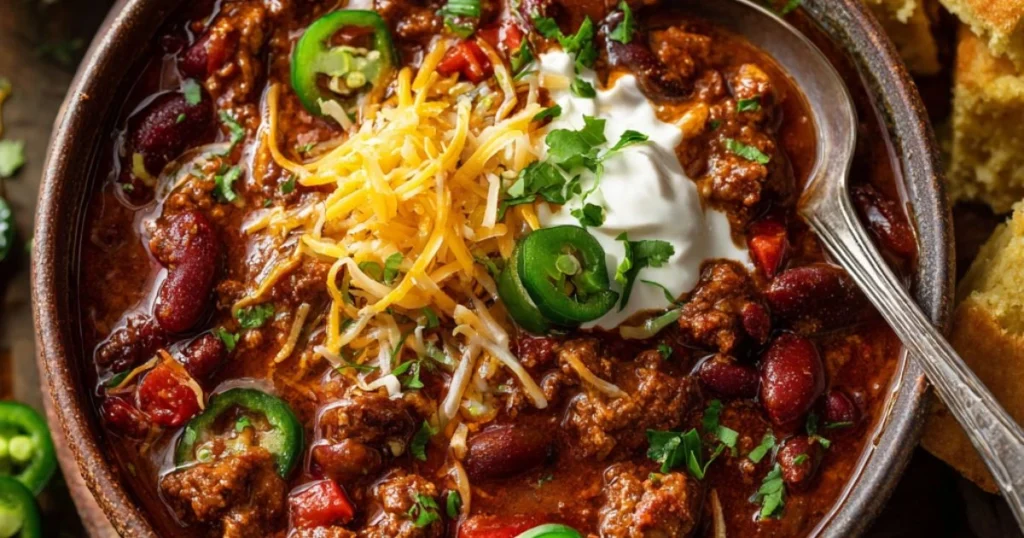
Regional Variations of Texas Chili
While the base recipe for Texas chili remains largely the same, regional differences exist. These variations reflect the diverse culinary influences in Texas, from the border regions to the Hill Country.
- Austin-style Chili: Known for its slightly spicier flavor, Austin-style chili often incorporates local craft beer or smoky chipotle peppers.
- Border-style Chili: In areas closer to Mexico, the chili might include tomatoes and beans, though this is often considered a more Tex-Mex approach.
- Hill Country Chili: This version might feature venison or wild game meat instead of traditional beef, reflecting the region’s hunting culture.
Pairing and Serving Texas Chili
When it comes to serving Texas chili, the rich, hearty flavors of the dish can be enhanced with the right accompaniments. Whether you’re hosting a chili cook-off or enjoying a cozy dinner, here are some great pairings to elevate the experience:
1. Classic Sides
- Cornbread: The slightly sweet flavor and crumbly texture of cornbread complement the spiciness of Texas chili, making it the perfect side dish. Serve it warm, with a dollop of butter on top.
- Tortilla Chips: Crunchy tortilla chips are ideal for scooping up chili or simply enjoying on the side. You can also use them as a base for a chili nacho dish.
- Rice: White rice is an excellent way to balance the heat of the chili while providing a neutral base for the flavorful stew.
2. Toppings and Garnishes
- Cheese: Shredded cheddar cheese or a handful of monterey jack adds a creamy element that contrasts the spiciness of the chili.
- Onions: Raw chopped onions or green onions bring a fresh crunch to each bite, helping to cut through the richness of the dish.
- Sour Cream: A dollop of sour cream offers a cool, creamy contrast to the warmth and heat of the chili.
3. Drinks
- Beer: Pair your Texas chili with a cold lager or dark beer like a stout for a refreshing balance to the spice.
- Iced Tea or Soda: For a non-alcoholic option, pair with a refreshing glass of iced tea or a fizzy soda to cleanse the palate.
These pairings make for a complete and satisfying meal, showcasing the bold flavors of Texas chili.
Storing and Reheating Texas Chili
Texas chili makes excellent leftovers, and its flavors only improve after a day or two. Here’s how to store and reheat it:
- Storing: Allow the chili to cool completely, then transfer it to an airtight container. It can be stored in the fridge for up to 3-4 days or frozen for up to 3 months.
- Reheating: To reheat, simply warm the chili on the stovetop over low heat, stirring occasionally. Add a splash of beef broth or water if it has thickened too much. For best results, gently heat it until it’s piping hot.
This makes Texas chili the perfect make-ahead dish!
FAQ About Texas Chili
1. Does Texas chili have beans?
No, traditional Texas chili does not include beans. The dish focuses on beef, chili peppers, and spices. The “no beans” rule is a point of pride for many Texans, as beans are seen as a filler that detracts from the true essence of the chili.
2. Can I use ground beef for Texas chili?
While you can use ground beef, it’s not the traditional choice. Texas chili is best made with cuts like beef chuck or brisket, which provide a richer, more tender texture. Ground beef will work but may not offer the same depth of flavor.
3. How spicy is Texas chili?
The heat level in Texas chili can vary depending on the type and amount of chili peppers used. Typically, it can range from mild to quite spicy. You can adjust the heat by controlling the type and quantity of peppers, such as jalapeños, cayenne, or chipotles.
4. Can I make Texas chili ahead of time?
Yes, Texas chili actually tastes better the next day! The flavors meld and intensify as it sits. Simply store it in an airtight container and refrigerate for up to 3-4 days. Reheat gently on the stovetop when ready to serve.
5. What’s the best chili pepper for Texas chili?
Ancho, Pasilla, and Guajillo are the most common peppers used in Texas chili, giving it a smoky, earthy flavor. Feel free to experiment with other dried chiles for unique variations.
Final Thoughts on Texas Chili
Making Texas chili is a rewarding and flavorful experience, whether you’re cooking it for a family dinner or entering it into a cook-off. The key is to focus on the quality of ingredients, the balance of spices, and the slow-cooking process that develops the rich, complex flavor profile. Whether you stick to the classic recipe or experiment with regional variations, Texas chili is sure to be a hit every time. Enjoy it with your favorite sides and a cold drink, and celebrate the bold flavors of this Texas classic!
Discover our recipe for Garlic Butter Beef Bites & Potatoes

